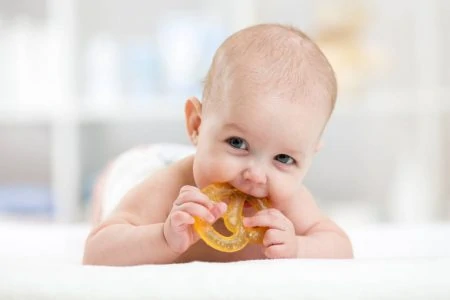Is your sweet baby suddenly acting like a drool monster?
Watching your little one cut their first tooth is a bittersweet milestone. You are excited to see them grow, but it’s tough to say goodbye to that gummy, toothless grin. Plus, seeing them in pain is never fun for a parent.
This guide covers when to expect those pearly whites, how to spot the signs, and the best ways to soothe those sore gums.

Signs of Teething
Unless your baby is a unicorn who breezes through milestones, you will likely know when teething starts. Some babies get a bit fussy, while others turn into tiny, agitated insomniacs.
When Does Teething Begin?
Most babies sprout their first tooth between 4 and 7 months. However, symptoms can start as early as 3 months (1).
Don’t panic if your friend’s baby has teeth at 3 months and yours doesn’t until 9 months. Genetics plays a huge role here. Early or late teething is rarely a cause for alarm; it just means your baby is on their own unique timeline.
What Do Teething Gums Look Like?
At first glance, everything might look normal. But if you peer closer (and risk a nip to the finger), you might notice changes.
The gums usually appear swollen, bruised, or red right where the tooth is trying to break through the surface.
What Are The Common Teething Symptoms?
While every baby handles pain differently, these are the telltale signs that a tooth is incoming (2):
- Drooling: If your baby turns into a faucet, suspect teething. Keep a stack of absorbent bibs handy to save their outfits.
- Coughing: Excess saliva can pool in the throat, causing gagging or a wet cough. If they seem otherwise healthy (no fever or cold symptoms), it is likely just the drool.
- Teething Rash: All that moisture can irritate the skin. You might see a red, bumpy rash on the chin, neck, or chest.
- Biting and Gnawing: Pressure relieves gum pain. Your baby will chew on anything available, including teething toys, crib rails, and your fingers.
- Fussiness: Pain makes people grumpy, and babies are no exception. This irritability can last for a few hours or drag on for weeks.
- Crying: The first few teeth and the molars usually cause the most discomfort. Sudden crying spells are common.
- Refusing Food: Suction increases blood flow to swollen gums, which hurts. Babies might push away the bottle or breast, or reject solids.
- Sleep Regression: Discomfort doesn’t punch out at 8 PM. Even good sleepers might wake frequently when a tooth is crowning.
- Ear Pulling: The nerves in the gums connect to the ears. Babies often tug on their ears to relieve the referred pain. However, always rule out an ear infection if this is accompanied by a fever.
What Are NOT Symptoms of Teething?
Parents often blame everything on teething, but medical experts differentiate between gum pain and illness. Call your doctor if you see these symptoms:
- Diarrhea: Teething does not cause explosive diapers. This is usually due to a virus or a change in diet.
- High Fever: A slightly elevated temperature is possible, but a true fever (over 100.4°F or 38°C) typically indicates an infection, not a tooth.
- Runny Nose: Congestion and runny noses are signs of a cold or allergies, not teething.
- Lethargy: A teething baby might be tired from lack of sleep, but they should not be limp or unresponsive.
Do Baby Teeth Need to be Brushed?
Yes. You should start oral care before the first tooth even arrives. Good habits now lead to healthy smiles later.
- Wipe the gums: Use a clean, damp cloth to wipe their gums daily.
- Start brushing: Once a tooth appears, use a soft-bristled brush and a rice-grain-sized amount of fluoride toothpaste.
- Skip the juice: Avoid sugary drinks that sit on the teeth and cause decay.
- Book the dentist: Schedule their first visit when the first tooth erupts or by their first birthday.
Remedies for Teething
You want to take the pain away; that is a natural parenting instinct. Here are 20 proven ways to help your baby feel better.
Teething Remedies to Avoid
Desperate times call for desperate measures, but safety comes first. Avoid these dangerous “remedies” regardless of what your grandmother suggests.
Avoid Baltic Amber Necklaces
Skip the jewelry. There is no scientific evidence that amber releases pain-relieving oils when touching the skin. More importantly, necklaces pose a serious strangulation and choking hazard. It is simply not worth the risk.
Avoid Benzocaine Gels
The FDA has issued strict warnings against using benzocaine products (like Anbesol or Orajel) for children under two.
These gels are linked to methemoglobinemia, a rare but potentially fatal condition that reduces the amount of oxygen in the blood.
Why It’s Dangerous
Avoid Essential Oils
Natural doesn’t always mean safe. Essential oils are highly concentrated and can be toxic if ingested or applied incorrectly to a baby’s delicate gums (4). Clove oil, specifically, can burn the gums and skin.
Avoid Alcohol (Whiskey)
This old-school advice needs to stay in the past. Rubbing whiskey on gums is dangerous. Even small amounts of alcohol can sedate a baby and cause dangerously low blood sugar.
Avoid Belladonna
Homeopathic teething tablets often contain belladonna (deadly nightshade). The FDA has found inconsistent amounts of this toxic substance in tablets, leading to seizures and adverse events in infants. Throw them out.
How Teething Affects Breastfeeding
Breastfeeding provides comfort, but teething can throw a wrench in your routine. Here is how to navigate the “nursing while teething” phase.
Your Baby May Bite
It is every nursing mom’s fear. Babies bite because they are exploring their new teeth or seeking pressure relief. To stop it:
- Pre-game: Let them chew on a cold washcloth or teether before nursing to numb the gums.
- Break the seal: If they bite, calmly break the suction with your finger and end the session briefly. Do not scream (if you can help it), as this might scare them into biting again.
- Switch methods: If your nipples are too traumatized, pump and offer a bottle or cup for a few feeds.
Your Baby May Nurse More
Nursing releases oxytocin and relieves pain, so your baby might want to be attached to you 24/7. This is great for them but tough on your nipples.
The best way to manage this is to go back to the basics of latching. Wait for a wide open mouth from baby, and be sure the latch is deep. Keep baby close to your body so that the nipple doesn’t get shallow in their mouth.
Editor's Note:
Michelle Roth, BA, IBCLCTo protect yourself, ensure a deep latch every time. Apply fresh breast milk or a lanolin-free nipple cream after feeds. Keep your nipples dry to prevent thrush or cracking; pat them gently rather than rubbing.
Your Baby May Go on a Strike
Conversely, suction can hurt sore gums, leading to a nursing strike. It can be stressful, but it is usually temporary.
Try nursing when your baby is sleepy (during naps or at night) when their guard is down. You can also offer the breast while walking or rocking. If they absolutely refuse, maintain your supply by pumping and offering milk in a cup or spoon.
When To Medicate































